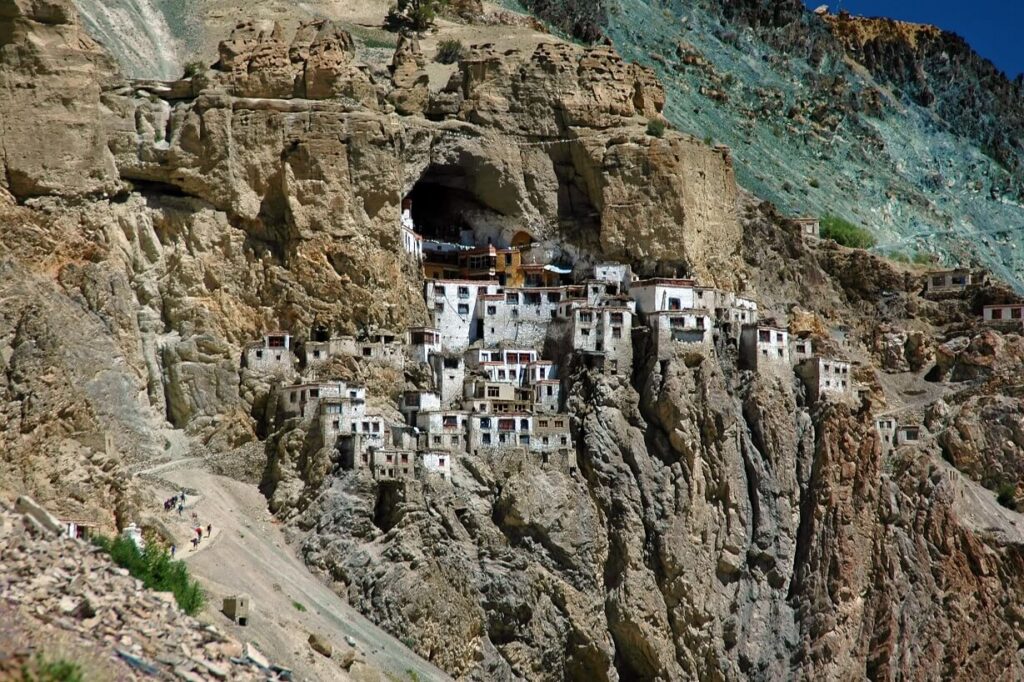Ephemeral surveillance of Kargil would give your ‘traveler’s instinct’ the easy slip and let you think it is the least likely place to go on a vacation. In fact, Kargil has been in the news more often than one would expect it to be and seldom for reasons that would highlight it as a travel getaway. Better known for the famous Kargil War of 1999, it is the second-largest city in Ladakh besides being the headquarters of the Kargil district and the unofficial capital of the Muslim portion of the region. Ensconced in the lap of the mighty Himalayas, Kargil offers an exciting challenge to adventure seekers as an important base station to Zanskar Valley and other exciting locations. Kargil is also a vital transit center for people traveling to Leh or Srinagar. Below is the travel guide to Kargil.
KARGIL | TRAVEL GUIDE
1. Zanskar Valley
Part of the Tethys Himalaya and separating the Zanskar District from Ladakh, the Zanskar Valley stands magnificently at an average height of 6,000 meters and is about 230 kilometers southeast of Kargil. Of all the trans-Himalayan valleys, Zanskar is said to be the most remote and is sandwiched between the Great Himalayan Range and the Zanskar Mountain. The valley is said to be one of the best places to immerse in some lengthened social detachment, owing to some of the calmest and the most remote meditation caves as well as some ancient monasteries. Zanskar Valley is an absolute darling of the numerous adventure lovers who come here seeking strenuous trekking expeditions across its length during summers when it’s accessible.
2. Rangdum Monastery
Belonging to the Gelugpa sect or the Yellow Hat sect, the Rangdum Monastery stands atop a precipitous hill at an altitude of 3,657 meters about 130 kilometers southeast of Kargil. This 18th century monastery is situated at the point from where the Suru Valley begins, offering the most amazing views of the surrounding mountains and a uniquely eye-catching stream that runs across its length. What draws visitors specifically to Rangdum Monastery is a small museum, which boasts of an impressive collection of rare artifacts from Tibet and other places. Rangdum Monastery is the place where you would want to be if peace is what you seek and prolonged isolation does not worry you.
3. Karsha Monastery
Karsha Monastery or Karsha Chamspaling, as it is also known, is an 11th-century monastic complex that was initially founded by the great translator Phagspa Shesrab and initiated into the Gelugpa or the Yellow Hat sect. Dedicated to Padmasambhava or Guru Rinpoche, the Karsha Monastery has various ancient rock carvings and structures, of which the Avalokiteshvara temple is said to be the oldest remaining to this very day. Within this temple are wall paintings that date way back to the 10th century during the time of the famous translator Rinchen Zangpo. The monastery also holds another interesting relic within it in the form of the bones of Dorje Rinchen.
4. Stongdey Monastery
Founded by the renowned Tibetan translator and yogi Lama Lhodak Marpa Choski Lodos or Marpa Lotsawa in the year 1052, Stongdey Monastery is the second largest monastic complex in the Zanskar region after Karsha Monastery. With a residential strength of about 60 Gelugpa monks, Stongdey Monastery is said to be served by administrators who are the reincarnations of Nari Tulku of the incarnate lamas of Tibet. During the 28th and 29th days of the eleventh month in the Tibetan calendar, the whole of Stongdey Monastery erupts in celebration of the annual Gustor festival. The monks and lamas of the monastery dress up in masked costumes of various deities to perform the sacred Cham dance during this festival.
5. Dzongkhul Monastery
Dzongkhul Monastery or Zongkul Gompa is a unique cave monastery in the Stod Valley of Zanskar region and rests on the Padum-Kishtwar trekking route right before the Umasi-la (Umasi Pass) begins. There is a legend attached to this monastery, which states that its founder was none other than the great Indian Buddhist yogi and monk Naropa from the famed Vikramshila University of Bihar. What’s more, the rock near the entrance to one of the caves is said to be embossed with a footprint that belongs to Naropa himself. A relaxing walk of about 10 minutes upwards will lead you to a viewing point from where you can take in the glory of the entire valley’s pristine beauty at your own languid and poetic pace.
6. Phugtal Monastery
Phugtal Monastery or Phugtal Gompa is one of the most enchanting as well as the most isolated monasteries in the southeastern Zanskar region in Ladakh. Founded in the early 12th century by Gangsem Sherap Sampo, Phugtal Monastery has been amazingly built at the mouth of a cave on the cliffside of a lateral gorge. This very gorge is actually a pathway for a major tributary of the southern Lungnak or Lingti-Tsarap River. It is said that there is a waterhole inside a cave above the monastery, whose water level never goes down no matter how much water one draws from it. One look at this monastery from a distance and the faint-hearted will retrace their steps. Ironically, it is this awesome feeling of being in a place, which almost seems like an organ of the entire mountain that attracts many of the visitors to this enigmatic monastery every year.
Related Article – BREATHTAKING ALCHI – LEH
Frequently Asked Questions About Kargil
Q. Why is Kargil famous?
A – Kargil city is famous for the Kargil War between India and Pakistan, which was fought between May and July, in the year 1999. The war was fought in the District of Kashmir, along the now-famous Line of Control or LOC, in India.
Q. Is Kargil in Pakistan?
A – The town and district of Kargil is in what is now called Jammu and Kashmir. The town lies on the Line of Control (LOC), the defacto border for the two nations, located 120 km (75 miles) from Srinagar, facing the Northern Areas of Pakistan. Like other areas in the Himalayas, it has a temperate climate.
Q. Can we go to Kargil?
A – Yes, it is possible but going all the way to Kargil and coming back does not make sense at all. Either you plan to exit/enter Kargil via Srinagar.
Q. Is Kargil capital of Ladakh?
A – Kargil is a town in Kargil district and the joint capital of the union territory of Ladakh. Kargil is the second largest town in Ladakh after Leh. It is located 204 km to the east of Srinagar and 234 km west of Leh to the east. Kargil is the centre of the Suru River valley, historically known as Purig.
A – Is Kargil worth visiting?
A – Kargil serves as an excellent destination for adventure activities such as trekking, camping, mountaineering, river rafting etc. Some of the major tourist attractions in this region are the Nun and Kun peaks, the Mulbek, the Zanskar Valley etc.
Q. How can I go to Kargil war memorial?
A – The Kargil War Memorial is right by the side of the highway going from Srinagar to Leh. If you are traveling by road from Delhi, you can reach Leh via the Leh – Manali Highway or Srinagar Leh Highway. From the town of Leh, the memorial is at a distance of 270 km.
Q. How far is Kargil from Srinagar?
A – 202 Kms is the Distance Between Srinagar to Kargil.
Q. Is Kargil safe for tourists?
A – Kargil is safe for tourists, nothing to worry about
Q. Which famous sightseeing location is present in Kargil?
A – The top attractions to visit in Kargil are: Dras War Memorial. Hunderman village. Phuktal Monastery.




















